Search
|
deer behavior
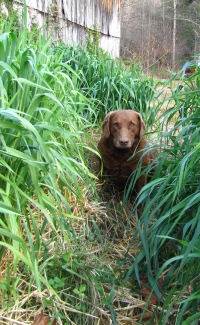 We've worked up a multi-prong approach to
keeping deer out of our garden. First, dot the edges with homemade deer
deterrents as the
main line of defense, but keep your eyes open. If you see a deer
too close, take a potshot over its head and then add another deterrent
in that spot. We've worked up a multi-prong approach to
keeping deer out of our garden. First, dot the edges with homemade deer
deterrents as the
main line of defense, but keep your eyes open. If you see a deer
too close, take a potshot over its head and then add another deterrent
in that spot.
This fall, I've added a
third leg to the anti-deer campaign --- cover crops. Fall and
early winter are the worst times for deer damage in the garden since
food sources in the woods largely disappear after the last acorn is
consumed. And while a summer deer visit just means that a leaf
here and there is nipped, the smaller and slower growing winter garden
can be completely defoliated in one night of deer gorging. Cover
crops give you a bit more wiggle room, since they are succulent and
tasty at this time of year, so they attract the deer's attention before
the beasts devour your beloved strawberry plants. I noticed that
during our two small deer incursions this fall, the plants that got
eaten most were oats around the garden edges, which left me smiling
instead of swearing.
Check out another one of
Mark's homestead innovations --- our homemade chicken
waterer that never
spills or fills with poop.
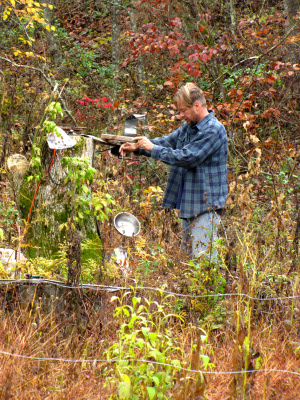 Mark has really kept on top
of the deer deterrents this summer, and we haven't
had a single incursion in months. In past years, deer damage was
already starting to get extreme by late October, but it's possible that
wild foods are especially abundant this year, keeping the deer well fed
in the woods and out of the garden. As always, it's a lot easier
to figure out why the deer got into the garden than to try to decipher
which factors are keeping them out, but I can't help pondering the
issue. Mark has really kept on top
of the deer deterrents this summer, and we haven't
had a single incursion in months. In past years, deer damage was
already starting to get extreme by late October, but it's possible that
wild foods are especially abundant this year, keeping the deer well fed
in the woods and out of the garden. As always, it's a lot easier
to figure out why the deer got into the garden than to try to decipher
which factors are keeping them out, but I can't help pondering the
issue.
Of all the natural
foods, acorns are perhaps the most important in a deer's fall
diet. Since oak trees mast --- produce few nuts
most years, then all gang up and produce a bumper crop during certain
years --- it's unsurprising that studies have shown varying percentages
of acorns in a deer's diet. A quick search of the web turns up
figures ranging from 20% to 75% for acorns' contribution to the diet of
a white-tailed deer.
Not all acorns are
created equal, though. Oaks can be divided into two large groups:
the white oaks, including white oak, chestnut oak, and others with
rounded lobes on their leaves; and the red oaks, including red oak,
black oak, scarlet oak, and others with pointy lobes on their
leaves.
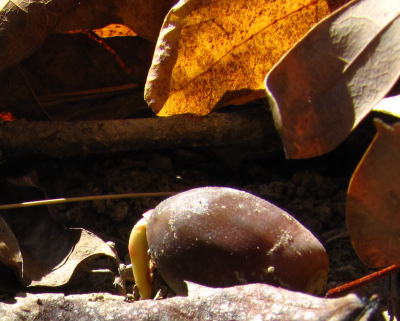
Although you might have a
hard time identifying the acorn you find on the forest floor, a deer is
much more discerning. Acorns in the white oak group are sweet,
with low concentrations of bitter tannins, so they are a preferred food
early in the fall. As you can see from this photo, though, white
oak acorns make up for their tastiness by sprouting quickly, so by late
October, there are often few unsprouted white oak acorns around for
deer to chomp on.
That's when red oak
acorns shine. With their bitter nuts, red oaks figure they can
wait until spring to sprout, and the tannins do deter many seed
predators. But by late fall, deer are getting hungry, so they
turn to the red oak acorns.
Since red and white oaks tend to
produce bumper crops during different years, deer often end up hungry
during either the early fall or late fall, but in our neck of the
woods, both red and white oak acorns are currently common on the
ground. Clearly, this double mast year has kept the deer very
well fed.
Looking for another homestead
invention that really works? Mark's homemade chicken
waterer keeps your
flock's drinking water poop-free.
I learned from reading Jim
Arnosky's excellent
juvenile book "All About Deer" a key element that must be fully
understood by the back yard deer deterrent maker.
"A deer can
swivel each of its ears around on its head to listen in two different
directions at once."
This fact indicates that even
the smallest garden could benefit by deploying at least two deterrents
at each end of the protected area.
In my opinion the sound puts
a deer in caution mode, but it's the movement that usually provokes
bolting.
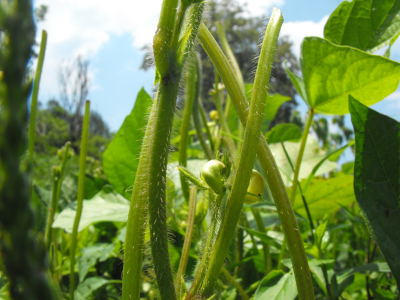 While
our garden is 80% better protected than last year, I have to admit that
our foes got in a couple of times this month and nibbled on some beans,
sweet potatoes, and strawberries. Looking back over my notes, I
noticed that the deer chomped
on our garden at the exact same time last year. I think the deer life cycle must involve shifting
feeding strategies in mid summer as the wild foods lose their spring
luster (especially when drought slows down growth in the woods.)
Now is the time to be hyper vigilant and stop deer damage before it
starts. While
our garden is 80% better protected than last year, I have to admit that
our foes got in a couple of times this month and nibbled on some beans,
sweet potatoes, and strawberries. Looking back over my notes, I
noticed that the deer chomped
on our garden at the exact same time last year. I think the deer life cycle must involve shifting
feeding strategies in mid summer as the wild foods lose their spring
luster (especially when drought slows down growth in the woods.)
Now is the time to be hyper vigilant and stop deer damage before it
starts.
On the other hand, I
think at least half of this year's deer damage could have been
prevented. After seeing no deer activity at all for months, we
got a bit lax and let some of our deer deterrents stop working for a few
weeks. Bad idea! Mark's currently inventing a more
dependable deterrent that won't get hung up or burn out its motor at
inopportune moments to prevent this problem in the future.
Meanwhile, we're keeping an eye out for signs of deer so that we'll
know when to upgrade our defenses. It also seems to have helped
to mow down a huge weedy patch at the edge of the garden where the deer
could find cover.
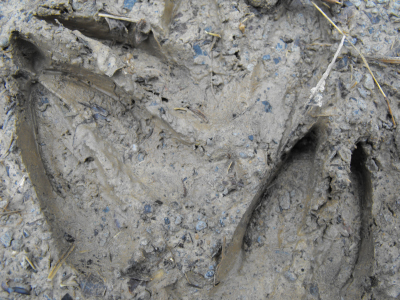
In December, our power
went out for two weeks and we stole all of our deer deterrents' extension cords to hook the
fridge and freezer up to the generator. After the power came back
on, we let our deer deterrents slide. After all, the deer were
following their winter paths, a good distance from our garden, and all
of our succulent perennials were under a thick mulch cover.
Recently, though, I've
been seeing hoof prints a bit too close for comfort. Tender
shoots are beginning to pop up both in the woods and the garden, and I
suspect the deer's gut bacteria are
making their shift
as well. I figure it's only a matter of a few days until they
discover that my strawberries are sending up new leaves, and then we'll
be done for.
So I sent Mark out this
week to plug the deterrents back in. It took him an hour or two
to get them all running, disentangling wind-blown chains and rewiring
bits that had pulled loose. Now I'm regaled by the gentle clang
of deterrents as I work in the garden, and am content that my fruits
and vegetables are safe for the moment.
One of the reasons our deer deterrent works so well is because of
the movement of the golf ball. I was reminded of this when a deer
walked quite close to me in the woods the other day. I had
stopped to rest, so the deer had a hard time deciding whether my still
form was just another stump in the forest or was something to be afraid
of. It watched and waited, stamping its hoof to try to startle me
into motion, then decided I wasn't a threat and wandered on its way.
The most effective deer
deterrents always seem to include some kind of motion. I
encourage you to keep this in mind when designing your own!
|
|
|

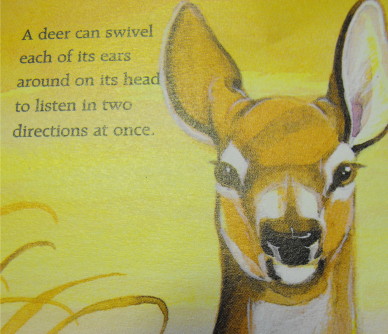

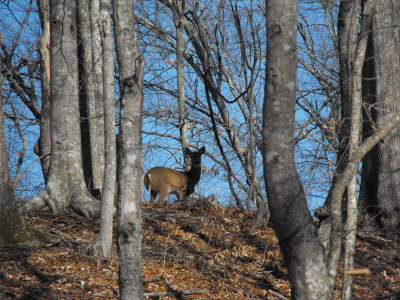
 We've worked up a multi-prong approach to
keeping deer out of our garden. First, dot the edges with
We've worked up a multi-prong approach to
keeping deer out of our garden. First, dot the edges with 

